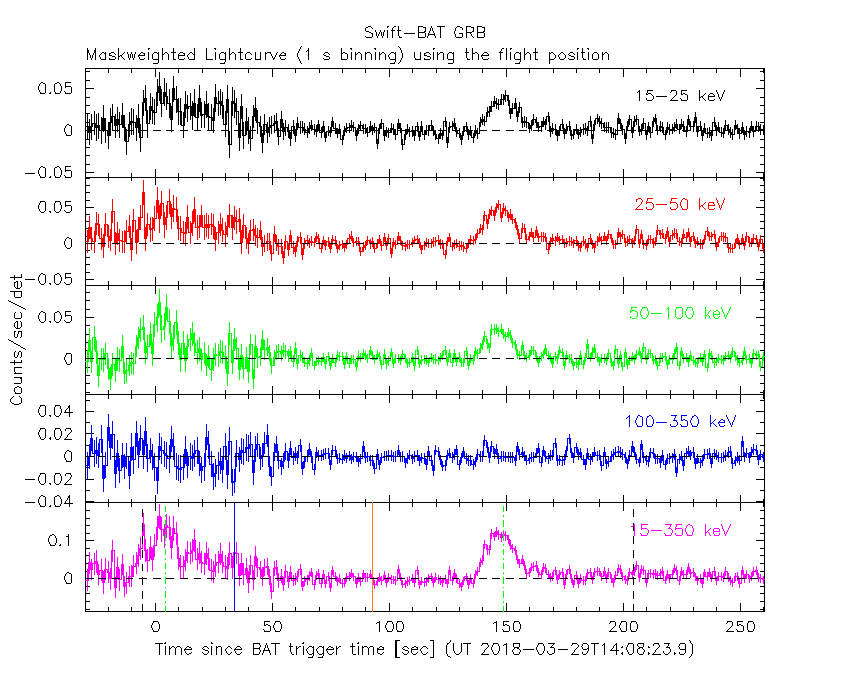
J.L. Racusin (NASA/GSFC), A. Melandri (INAF-OAB) and S.W.K. Emery (UCL-MSSL) for the Swift team
At 14:08:23 UT, the Swift Burst Alert Telescope (BAT) triggered and located GRB 180329B (trigger=819490) (Racusin et al. GCN Circ. 22558). Swift slewed immediately to the burst. At the time of the trigger, the initial BAT position was 78° from the Sun (5.0 hours East) and 87° from the 95%-illuminated Moon. Table 1 contains the best reported positions from Swift, and the latest XRT position can be viewed at http://www.swift.ac.uk/xrt_positions.
Racusin et al. (GCN Circ. 22558) reported the discovery with UVOT of an optical afterglow. Perley et al. (GCN Circ. 22562) reported the position from NOT for the optical afterglow of this GRB. Izzo et al. (GCN Circ. 22567) determined a redshift of 1.998 from VLT. Table 2 is a summary of GCN Circulars about this GRB from observatories other than Swift.
Standard analysis products for this burst are available at https://gcn.gsfc.nasa.gov/swift_gnd_ana.html.
As reported by Palmer et al. (GCN Circ. 22566),
the BAT ground-calculated position is RA, Dec = 82.905, -23.694 deg which is RA(J2000) = 0
The mask-weighted light curve (Figure 1) shows a triple-peaked structure, with the first peak running from T-10 to T+40 s, and the second peak from T+130 to T+160 s.
This is followed by a much weaker, softer peak from T+160 to T+280 s.
The time-averaged spectrum from T-9.91 to T+230.39 s is best fit by a power law with an exponential cutoff.
This fit gives a photon index 0.97 ± 0.56, and
The results of the batgrbproduct analysis are available at https://gcn.gsfc.nasa.gov/notices_s/819490/BA/.
Analysis of the initial XRT data was reported by Melandri et al. (GCN Circ. 22560). We have analysed 21 ks of XRT data for GRB 180329B, from 109 s to 190.3 ks after the BAT trigger. The data comprise 260 s in Windowed Timing (WT) mode with the remainder in Photon Counting (PC) mode. The enhanced XRT position for this burst was given by Beardmore et al. (GCN Circ. 22559).
The late-time light curve (Figure 2) (from T0+4.6 ks) can be modelled with a power-law decay with a decay index of α=1.29 ± 0.06.
A spectrum formed from the WT mode data can be fitted with an absorbed power-law with a photon spectral index of 1.52 ± 0.03. The best-fitting absorption column is 2.9 (+0.9, -0.8) x 1
A summary of the PC-mode spectrum is thus:
Galactic foreground: 2.5 x 1
Intrinsic column: 2.6 (+1.8, -1.7) x 1
Photon index: 1.87 ± 0.09
The results of the XRT team automatic analysis are available at http://www.swift.ac.uk/xrt_products/00819490.
The Swift/UVOT began settled observations of the field of GRB 180329B 113 s after the BAT trigger
(Emery and Racusin GCN Circ. 22565).
A fading source consistent with the XRT position (Beardmore et al. GCN Circ. 22559) also detected by the NOT (Perley et al. GCN Circ. 22562) and RATIR (Watson et al. GCN Circ. 22564) is detected in the initial UVOT exposures.
Table 3 gives preliminary
magnitudes using the UVOT photometric system
(Breeveld et al. 2011, AIP Conf. Proc., 1358, 373).
No correction has been made for the expected extinction in the Milky Way
corresponding to a reddening of

Figure 1. The BAT
mask-weighted light curve in the four individual and total
energy bands. The units are counts

Figure 2. The XRT light curve.
Any data from a crosshatched region are not included in the fit.
| RA (J2000) | Dec (J2000) | Error | Note | Reference |
|---|---|---|---|---|
| 0 |
-23°41'25.8" | 0.43" | UVOT-refined | Emery and Racusin GCN Circ. 22565 |
| 0 |
-23°41'27.4" | 1.4" | XRT-final | UKSSDC |
| 0 |
-23°41'27.1" | 1.7" | XRT-enhanced | Beardmore et al. GCN Circ. 22559 |
| 0 |
-23°41'39.8" | 1.8' | BAT-refined | Palmer et al. GCN Circ. 22566 |
| Band | Authors | GCN Circ. | Subject | Observatory | Notes |
|---|---|---|---|---|---|
| Optical | Perley et al. | 22562 | NOT optical afterglow detection | NOT | detection |
| Optical | Watson et al. | 22564 | RATIR Optical Observations | RATIR | |
| Optical | Izzo et al. | 22567 | VLT/X-shooter spectroscopic observations | VLT | |
| Optical | Guidorzi et al. | 22571 | LCO FTS observations | FTS | detection |
| Filter | Exp(s) | Mag | ||
|---|---|---|---|---|
| white | 113 | 263 | 147 | 17.69 ± 0.04 |
| white | 550 | 6892 | 599 | 17.64 ± 0.03 |
| v | 601 | 5867 | 274 | 17.25 ± 0.07 |
| b | 526 | 6687 | 452 | 17.94 ± 0.05 |
| u | 271 | 6482 | 697 | 17.00 ± 0.04 |
| u | 16039 | 39219 | 1961 | 18.74 ± 0.07 |
| w1 | 650 | 6277 | 452 | 18.72 ± 0.14 |
| m2 | 626 | 6073 | 274 | >19.8 |
| w2 | 577 | 7017 | 390 | >20.2 |
Table 3. UVOT observations reported by Emery and Racusin (GCN Circ. 22565). The start and stop times of the exposures are given in seconds since the BAT trigger. The preliminary detections and 3-σ upper limits are given. No correction has been made for extinction in the Milky Way.
April 1, 2018